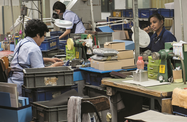A new investment drive to make Johor the centre of Malaysia’s nascent robotics industry is moving ahead, part of a broader push to attract more high-tech developments.

In mid-May Malaysia’s Johor Corporation (JCorp) signed a letter of intent on cooperation with China’s Siasun Robot Investment, outlining plans to develop a large-scale centre for robotics research and development. Under the deal, Siasun will invest RM15bn ($3.5bn) in a project dubbed the Robotic Future City.
Covering an area of more than 400 ha in west Johor Baru, the state’s capital city, the site will include a planned regional base for Siasun, including robotics equipment and components, parts production facilities, research and development (R&D) labs, and a service centre.
The agreement builds on a memorandum of understanding signed in mid-April between JCorp, the Malaysian Investment Development Authority (MIDA) and Siasun subsidiary Beijing Huize Boyuan Robot Investment.
The centre’s development will further the government’s objective of creating high-income jobs and accelerate economic growth in the state of Johor, according to Kamaruzzaman Abu Kassim, president and CEO of JCorp.
“This strategic cooperation with Siasun represents a significant step towards leveraging advanced technologies in the areas of robotics, innovation and automation to benefit Johor and Malaysia,” he said in mid-May.
Malaysian officials have said they hope initial investments in the project will start to flow before the end of the year.
New arena
The Johor robotics agreement was one of nine business deals with a combined value of RM31.3bn ($7.3bn) inked between Malaysian and Chinese firms during a five-day visit to China by a delegation led by Prime Minister Najib Razak.
While other investments pledged during the trip focused on established sectors such as petrochemicals and logistics, the planned robotics centre represented a breaking of new ground.
As the first large-scale foreign investment in Malaysia’s robotics sector, the Johor project is expected to shape the industry’s future and generate the right set of conditions to attract further projects.
The push to build up production capacity in robotics comes as Malaysia’s industries try to keep abreast of a changing operational environment, according to Datuk N Rajendran, deputy CEO of MIDA.
“In line with the Industry 4.0 [the so-called fourth industrial revolution of digitally-driven manufacturing], local companies need to adopt automation, robotics, smart technologies and invest in R&D, and upskilling of talent to stay competitive,” he told an investment seminar in mid-May.
Developing a skilled workforce
Robotics is also a sector the government hopes will help drive the country’s next wave of industrial development, moving it up in the global value chain by reducing dependence on low-skilled jobs and increasing the number of high-skilled employees.
However, as Manoj Menon, managing director of Frost & Sullivan in Johor, told OBG, “Attracting talent is one of the major challenges for companies operating in Johor: a weaker ringgit makes local salaries uncompetitive compared to those offered in neighbouring Singapore”.
In the face of this issue, a shortage of skilled labour could be ameliorated through the government’s commitment to bringing internationally recognised private universities into EduCity – an integrated education hub in the Iskandar special economic region in Johor – according to Manoj.
Looking beyond China
China is rapidly becoming both a leading developer and a top market for robotics, making it a strong partner for Malaysia.
An early-April report by market research firm International Data Corporation (IDC) estimates that Chinese spending on robotics and related services will more than double to $59.4bn by 2020, reaching a 30% share of the global total that year.
Such increases will likely be driven by firms like Siasun, the world’s third-largest robotics developer and China’s biggest, which now has a market capitalisation of RM25bn ($5.8bn).
Malaysia has, however, been keen to promote its robotics potential beyond China’s shores.
During a trade-promotion road show in South Korea in mid-April, Mustapa Mohamed, Malaysia’s minister of international trade and industry, said his country hoped to develop tie-ups with Korean firms in the sector.
“We are interested in the automation and robotics industries, which South Korea has strength in,” he said. “We want to improve productivity of Malaysian small and medium-sized enterprises, so we encourage partnerships and joint ventures between companies from both countries.”
Expanding the market
Malaysia is also looking to incorporate robotics into spheres beyond industry, such as the banking sector.
Some of its banks are already considering using advanced technology to improve services and support growth, according to Liew Nam Soon, managing partner for financial services at EY ASEAN.
“These banks typically engage with them for projects revolving around mobile banking, payments, and loyalty programs,” he told local media in early May. “Others are looking at robotics or automation of their front- and back-office operations, including chatbots in place of call centres and electronic ‘Know Your Customer/Anti-Money-Laundering’ enablers.”
As interest in Malaysian manufacturing continues to rise, and as new ways of combining automation with “big data” are discovered, Johor’s robotics centre stands a good chance of building a waiting list of prospective clients before it breaks ground.


